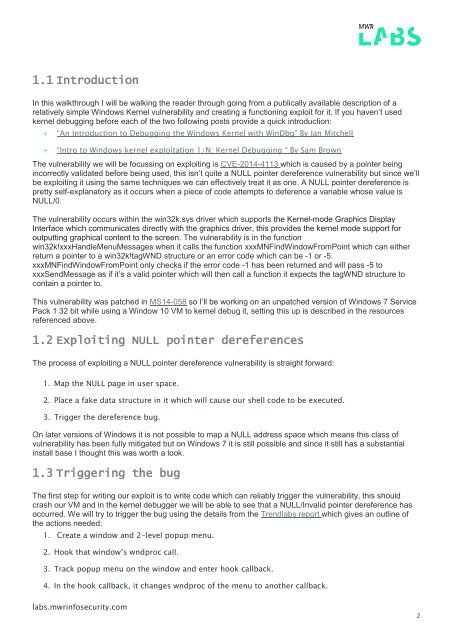Windows Kernel Exploitation 101 Exploiting CVE-2014-4113
bDD8JK
bDD8JK
You also want an ePaper? Increase the reach of your titles
YUMPU automatically turns print PDFs into web optimized ePapers that Google loves.
1.1 Introduction<br />
In this walkthrough I will be walking the reader through going from a publically available description of a<br />
relatively simple <strong>Windows</strong> <strong>Kernel</strong> vulnerability and creating a functioning exploit for it. If you haven’t used<br />
kernel debugging before each of the two following posts provide a quick introduction:<br />
+ “An Introduction to Debugging the <strong>Windows</strong> <strong>Kernel</strong> with WinDbg” By Jan Mitchell<br />
+ “Intro to <strong>Windows</strong> kernel exploitation 1/N: <strong>Kernel</strong> Debugging “ By Sam Brown<br />
The vulnerability we will be focussing on exploiting is <strong>CVE</strong>-<strong>2014</strong>-<strong>4113</strong> which is caused by a pointer being<br />
incorrectly validated before being used, this isn’t quite a NULL pointer dereference vulnerability but since we’ll<br />
be exploiting it using the same techniques we can effectively treat it as one. A NULL pointer dereference is<br />
pretty self-explanatory as it occurs when a piece of code attempts to deference a variable whose value is<br />
NULL/0.<br />
The vulnerability occurs within the win32k.sys driver which supports the <strong>Kernel</strong>-mode Graphics Display<br />
Interface which communicates directly with the graphics driver, this provides the kernel mode support for<br />
outputting graphical content to the screen. The vulnerability is in the function<br />
win32k!xxxHandleMenuMessages when it calls the function xxxMNFindWindowFromPoint which can either<br />
return a pointer to a win32k!tagWND structure or an error code which can be -1 or -5.<br />
xxxMNFindWindowFromPoint only checks if the error code -1 has been returned and will pass -5 to<br />
xxxSendMessage as if it’s a valid pointer which will then call a function it expects the tagWND structure to<br />
contain a pointer to.<br />
This vulnerability was patched in MS14-058 so I’ll be working on an unpatched version of <strong>Windows</strong> 7 Service<br />
Pack 1 32 bit while using a Window 10 VM to kernel debug it, setting this up is described in the resources<br />
referenced above.<br />
1.2 <strong>Exploiting</strong> NULL pointer dereferences<br />
The process of exploiting a NULL pointer dereference vulnerability is straight forward:<br />
1. Map the NULL page in user space.<br />
2. Place a fake data structure in it which will cause our shell code to be executed.<br />
3. Trigger the dereference bug.<br />
On later versions of <strong>Windows</strong> it is not possible to map a NULL address space which means this class of<br />
vulnerability has been fully mitigated but on <strong>Windows</strong> 7 it is still possible and since it still has a substantial<br />
install base I thought this was worth a look.<br />
1.3 Triggering the bug<br />
The first step for writing our exploit is to write code which can reliably trigger the vulnerability, this should<br />
crash our VM and in the kernel debugger we will be able to see that a NULL/Invalid pointer dereference has<br />
occurred. We will try to trigger the bug using the details from the Trendlabs report which gives an outline of<br />
the actions needed:<br />
1. Create a window and 2-level popup menu.<br />
2. Hook that window’s wndproc call.<br />
3. Track popup menu on the window and enter hook callback.<br />
4. In the hook callback, it changes wndproc of the menu to another callback.<br />
labs.mwrinfosecurity.com<br />
2



